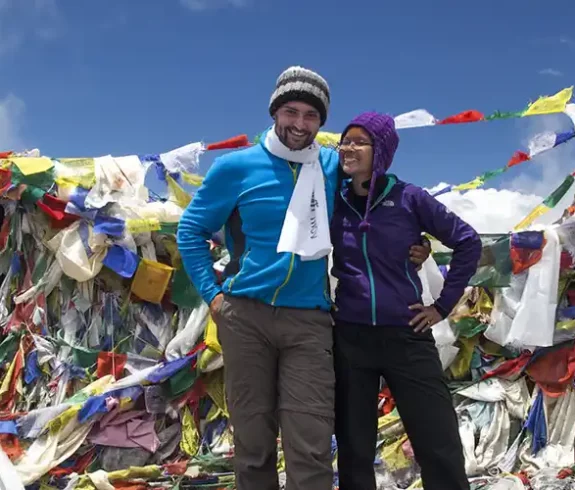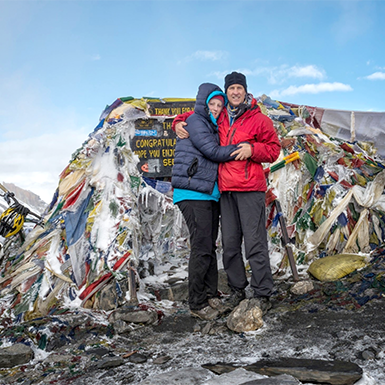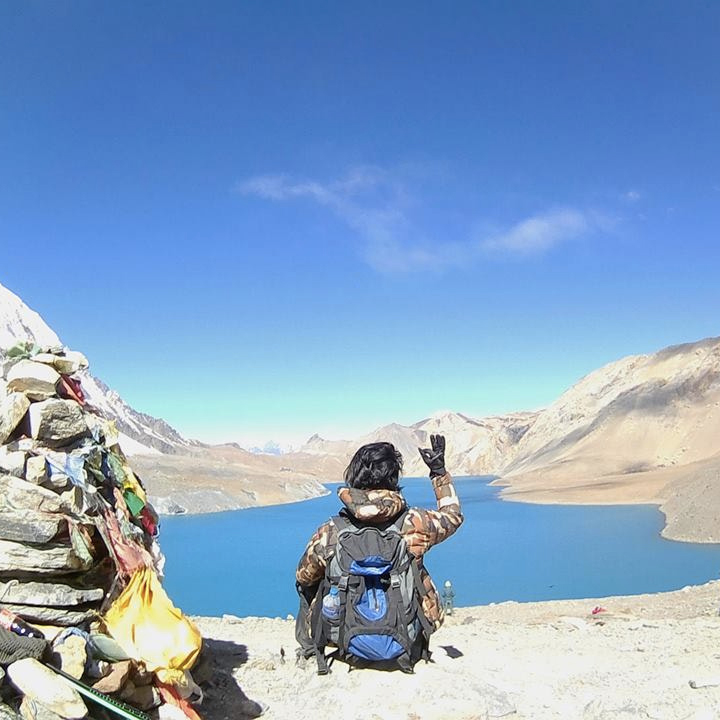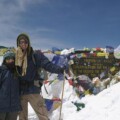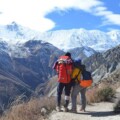Standing at a breathtaking height of 5,416 meters (17,769 feet), Thorong La Pass is a significant attraction on the Annapurna Circuit, widely acclaimed as one of the world’s best trekking routes. Since then, this pass that has been part of the circuit has become an adventurer’s destination, drawing people from all corners of the world to get a feel for the strength and perseverance required to tackle whatever comes their way while traversing through the Himalayas’ challenging geography.
For ages, it has acted as a bridge between Nepal’s Manang and Mustang regions, promoting trade and cultural contacts, among other things. Nowadays, it serves as a significant milestone for those who begin on the Annapurna Circuit, where they have panoramic views of both the Annapurna and Dhaulagiri Mountain ranges while at the same time pushing themselves to their limits within one of the harshest climates on earth.
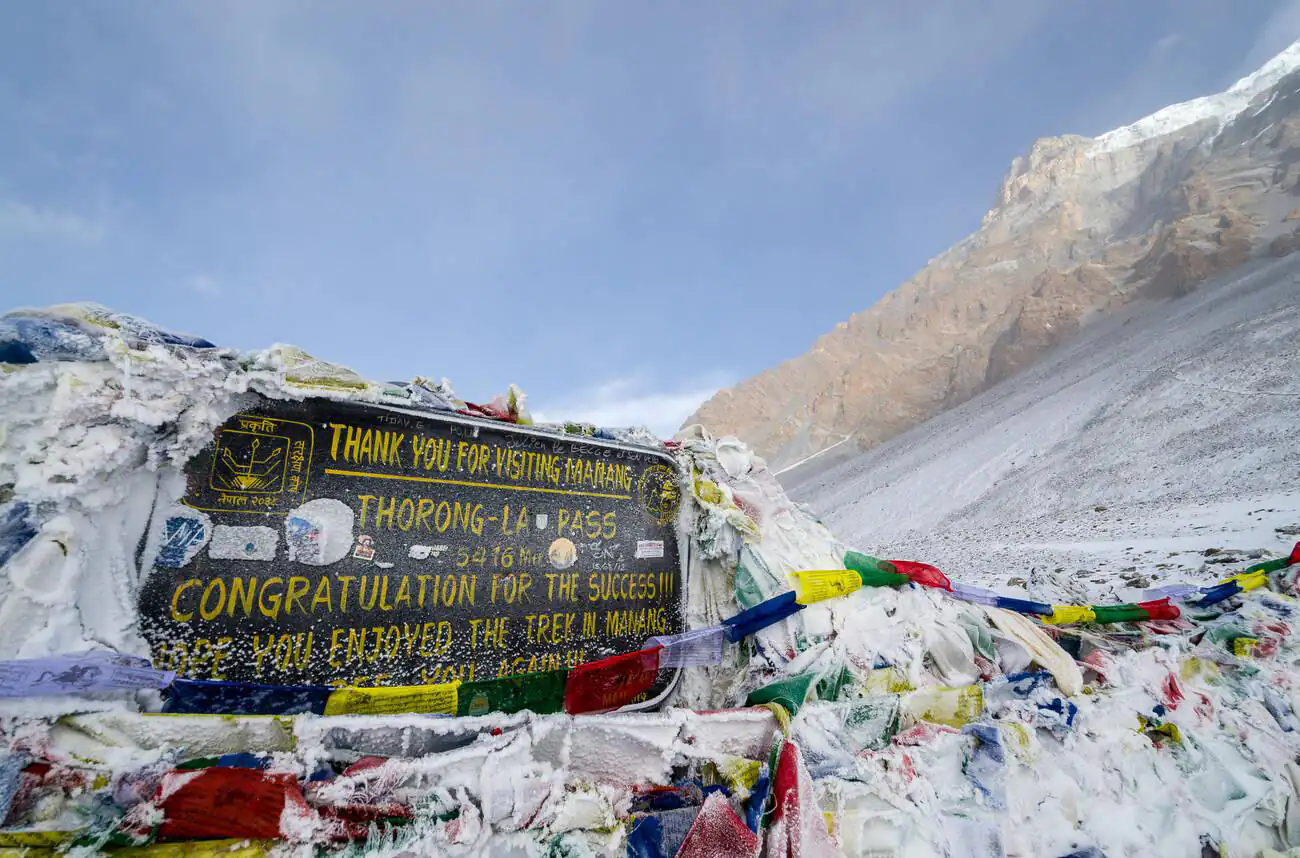
Geographic Location and Significance of Thorong La Pass
- Position on the Annapurna Circuit: Nestled in the Annapurna Conservation Area of Nepal, Thorong La Pass connects the villages of Manang and Muktinath. It forms an essential part of the Annapurna Circuit, which trekkers can navigate clockwise or counterclockwise, encircling the Annapurna Massif.
- Among the Highest Passes: Standing out for its high elevation, Thorung La Pass challenges even the most experienced trekkers with its altitude. At 5,416 meters, it often represents the circuit’s apex, celebrating a notable feat for those who traverse it.
- Historical Trade Route: Historically, Thorong La Pass served as a vital trade route, bridging the lush valleys of Manang with Mustang’s stark landscapes. Its strategic significance continues to benefit local traders and communities.
- Panoramic Views: From its high vantage point, the pass offers expansive views of towering peaks such as Annapurna I, Gangapurna, and Dhaulagiri. The dramatic contrast between the snow-covered summits and Mustang’s arid terrain mesmerizes trekkers.
- Cultural and Spiritual Hub: Thorung La Pass also holds deep cultural and spiritual value. Nearby, the Muktinath Temple, revered by Hindus and Buddhists alike, enriches visitors’ spiritual trek, making the pass a physical and spiritual passage site.
Exploring the Geography and Topography of Thorong La Pass
Despite its jagged and rough terrain, Thorong La Pass is visible in the Annapurna Circuit and surrounded by stunning views. Every hiker trekking in the Annapurna region should experience this pass, located deep in the Himalayas, for its unique combination of mountain majesty and personal challenge.
Landscape and Terrain Surrounding Thorong La Pass
The terrain around the pass varies dramatically. As trekkers approach, they move through different environments, starting with lush valleys at lower altitudes and ascending to rocky, barren landscapes. The trail twists through steep hillsides, narrow pathways, and rocky outcrops, ensuring the scenery changes constantly.
- Vegetation Zones: The trek to the pass begins in the lower Annapurna region, where dense rhododendron and pine forests dominate the landscape. As trekkers gain altitude, the greenery fades into alpine meadows, eventually giving way to the stark, rocky terrain closer to the pass.
- Glacial Features: Higher altitudes reveal glacial moraines and ancient rock formations, evidence of the region’s glacial past. These features enhance the area’s rugged beauty, visually rewarding the trek.
- High-Altitude Desert: Near the summit, the landscape resembles a high-altitude desert. The barren, windswept slopes support only the hardiest shrubs and grasses. This stark environment, paired with the snow-capped peaks in the distance, creates a surreal and captivating atmosphere.
Elevation and Its Associated Challenges
The Thorong La Pass elevation reaches a staggering 5,416 meters (17,769 feet), presenting several challenges that trekkers must prepare for.
- Dealing with Altitude Sickness: At this elevation, altitude sickness becomes a genuine concern. As trekkers ascend, the air thins, reducing oxygen levels. Symptoms like headaches, dizziness, nausea, and fatigue can occur. Trekkers should ensure they acclimatize properly, take regular breaks, and stay hydrated to minimize risks.
- Handling Cold Weather: The weather near the pass can be extremely harsh, particularly in winter. Temperatures drop sharply, and strong winds intensify the cold, making proper gear and clothing essential. Rapid weather changes are common even in warmer seasons, so being prepared is critical.
- Physical Demands: High elevation and challenging terrain combination require a strong fitness level. The trek involves steep climbs and descents that challenge even experienced trekkers. Training for strength and endurance can make the trek more enjoyable and less strenuous.
- Navigating Snow and Ice: Depending on the season, snow and ice may cover the trail near the pass, adding an extra layer of difficulty. Careful footing is essential; trekking poles or crampons may sometimes be necessary for safety.
Climatic Conditions at Thorong La Pass
Trekking through Thorong La Pass on an Annapurna Circle presents stunning sights and difficulties, particularly concerning the weather. Understanding the weather conditions at this high altitude is essential for a happy and safe trip. Here is a discussion on seasonal weather changes, ideal visiting times, and necessary preparation guidelines.
Seasonal Variations in Thorong La Pass Weather
- Spring (March to May): Spring brings mild and stable weather to Thorung La Pass, making it an ideal time for trekking. The daytime temperature in the lower elevations typically falls between 10°C and 15°C (50°F to 59°F). As you climb higher, temperatures decrease, especially at night, often dropping below freezing. Clear skies are familiar this season, offering stunning views of the peaks and the vibrant colors of blooming rhododendrons along the trail.
- Summer/Monsoon (June to August): The monsoon season introduces heavy rainfall, making the trails more challenging and increasing the risk of landslides. Although the pass remains relatively dry due to the Annapurna range’s rain shadow effect, the high humidity and frequent rain can make the trek uncomfortable. Visibility often decreases due to cloud cover, and this season is generally less famous for trekking.
- Autumn (September to November): Autumn is the peak trekking season at Thorong La Pass. The stable weather, with clear skies and crisp air, makes it perfect for outdoor activities. The daytime temperature in the lower regions typically falls between 10°C and 20°C (50°F to 68°F), but temperatures near the pass can drop dramatically at night, often dipping below freezing. The post-monsoon period offers the clearest views, and the trails are busy with trekkers worldwide.
- Winter (December to February): Winter brings extreme conditions, with heavy snowfall and freezing temperatures. Daytime temperatures near the pass can range from -10°C to -5°C (14°F to 23°F), and at night, they can plummet to -20°C (-4°F) or lower. Deep snow often covers the pass, making crossing difficult or impossible. Only experienced trekkers with the right gear should consider trekking this season.
Preparing for Weather Conditions at Thorong La Pass
Proper preparation is essential when facing the unpredictable weather at Thorong La Pass. Here are practical tips to help you get ready:
- Wear Layered Clothing: Shift temperature by employing a combination of layers. First, put on a base layer that will wick sweat off your skin; next, add insulation as an intermediate level; finally, wrap it up with an outermost layer impervious to water. This way, you can keep yourself content all day since atmospheric conditions vary.
- Pack Cold Weather Gear: Bring high-quality cold-weather gear for trekking during the colder months. Items like a down jacket, thermal gloves, a warm hat, and insulated boots are necessary to stay warm at higher altitudes. A balaclava or neck gaiter can help protect your face from the cold wind.
- Bring Rain Protection: Unexpected rain or snow showers can occur, even during the drier seasons. Pack a lightweight, waterproof jacket and a rain cover for your backpack. Quick-drying clothing is also a good idea to ensure comfort in wet conditions.
- Use Sun Protection: The sun’s UV rays are more potent at high altitudes, so it’s essential to wear a hat, sunglasses, and sunscreen with a high SPF. Protecting your skin and eyes from the sun is as crucial as staying warm.
- Stay Hydrated and Nourished: In a nutshell, a lack of sufficient water intake when you are climbing high altitudes can cause dehydration. Always have a water container with a built-in purifier; drink from it consistently. Also, pack food items that contain lots of energy to restore your energy levels while hiking.
- Acclimatize Properly: Spend a few days acclimatizing at higher elevations before attempting to cross the pass. This process helps your body better adapt to the reduced oxygen levels, minimizing the chance of altitude sickness.
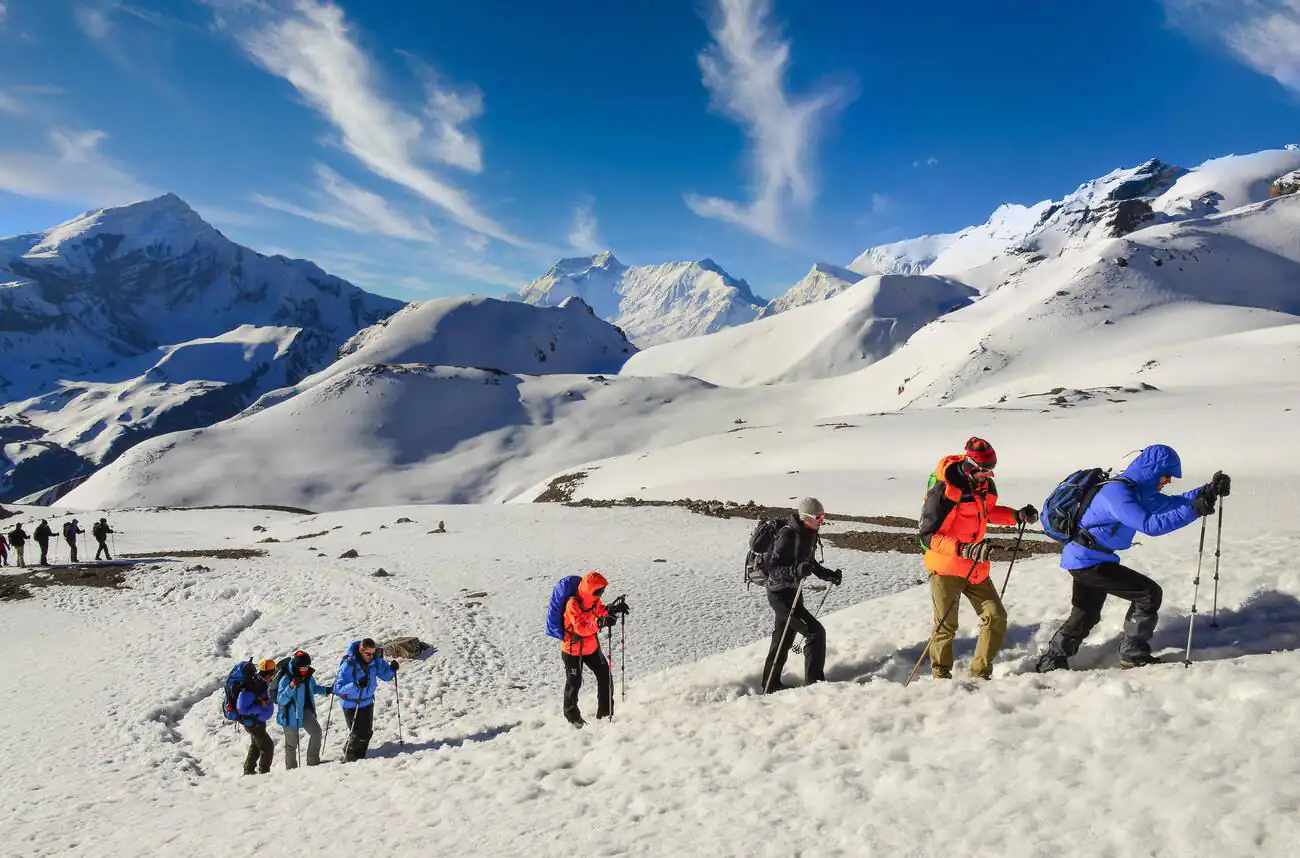
Trekking to Thorong La Pass
Thorong La Pass is a prominent feature on the Annapurna Circuit, challenging trekkers with its high altitude and breathtaking panoramas. This guide details the two main routes to the pass from Manang and Muktinath, providing insights into each trek step, highlighting essential landmarks, and measuring distances.
Route from Manang to Thorong La Pass
Manang is a favored starting point for trekkers heading to Thorung La Pass due to its gradual ascent and ample acclimatization opportunities.
- From Manang to Yak Kharka (10 km, 4-5 hours): The trek begins in Manang and ascends to Yak Kharka, reaching an elevation of 4,050 meters. Along this path, trekkers enjoy spectacular views of the Annapurna range and traverse through alpine scenery dotted with yak pastures. This segment offers a mild trek, allowing for gradual adaptation to higher altitudes.
- From Yak Kharka to Thorong Phedi (7 km, 3-4 hours): The trail from Yak Kharka to Thorong Phedi becomes more challenging, with rocky paths and steeper gradients. At an elevation of 4,540 meters, Thorong Phedi acts as the base camp for those preparing to conquer the pass.
- From Thorong Phedi to Thorong La Pass (6 km, 4-5 hours): This segment is the most demanding. It involves a steep climb to the pass, which lies at 5,416 meters, the circuit’s highest point. Trekkers reach the summit to find stunning views of the Annapurna and Dhaulagiri ranges. Prepare for potentially cold and snowy conditions.
- From Thorong La Pass to Muktinath (10 km, 4-5 hours): After the pass, the path descends sharply towards Muktinath, a revered site for Hindus and Buddhists. The descent can be tricky on the knees, making trekking poles necessary. Muktinath provides a welcome break to recuperate after the trek.
Route from Muktinath to Thorong La Pass
Starting from Muktinath means facing a steeper route to Thorung La Pass, requiring careful acclimatization.
- From Muktinath to Thorong La Pass (10 km, 6-7 hours), trekkers encounter a relentless uphill challenge. The landscape becomes rugged, and the air colder as they climb. Expect changing weather conditions as they approach the pass.
- From Thorong La Pass to Thorong Phedi (6 km, 4-5 hours): The descent to Thorong Phedi provides relief after reaching the pass. Despite the steep trail, the views of the Himalayan peaks are rewarding. Thorong Phedi offers accommodation and rest.
- From Thorong Phedi to Yak Kharka (7 km, 3-4 hours): Continuing the descent, the path to Yak Kharka becomes more accessible as the altitude decreases. It is an ideal spot to rest and reflect on the trek.
- From Yak Kharka to Manang (10 km, 4-5 hours): The final leg returns to Manang, where the terrain softens and lush landscapes welcome trekkers. Manang is well-equipped to serve trekkers and provides a perfect spot to celebrate the successful completion of the trek across Thorung La Pass.
Navigating the Challenges of Thorong La Pass: A Guide to Preparation and Training
Thorong La Pass, a standout feature of the Annapurna Circuit, challenges trekkers physically and mentally. This guide delves into the complexities of “Thorong La Pass difficulty.” It offers structured training advice and preparation strategies to ensure a successful and secure passage, catering to various fitness levels.
Decoding the Difficulty of Thorong La Pass
Thorong La Pass, sitting at an elevation of 5,416 meters, is one of the highest trekking passes in the world. Its lofty altitude, steep inclines, and unpredictable weather collectively enhance its difficulty.
- Physical Challenges: Trekking through Thorung La Pass demands endurance, strong leg muscles, and robust cardiovascular health due to long days, steep climbs, and significant altitude gains.
- Mental Challenges: As rigorous as a cognitive test can be, removing oneself from these distant places and incredible landscapes is impossible. One way to prepare for the trek involves using mindfulness or special techniques for dealing with stress that can keep one focused during challenging moments.
Training and Preparation Strategies for Different Fitness Levels
Tailored preparation is essential for safely navigating Thorong La Pass, enhancing the trek’s enjoyment and reducing health risks.
- Beginners: Newcomers to high-altitude trekking should begin their preparation months ahead. Building stamina through running, cycling, or swimming is crucial. Strength training, especially targeting the legs and core, prepares the body for the physical demands of the trek. Additionally, regular hikes in varied terrain can help adapt to similar conditions.
- Intermediate Trekkers: Those with trekking experience should focus on bolstering endurance and strength. Engaging in prolonged cardiovascular workouts that simulate extended trekking periods, like weekend-long hikes, can be particularly beneficial. Using altitude training masks or practicing in higher elevations may also help acclimate your body to reduced oxygen levels.
- Advanced Trekkers: Seasoned trekkers should continue their fitness regimen while honing specific skills such as navigation and survival tactics. Incorporating hikes with a fully loaded backpack can simulate the actual trekking experience. Sleeping in a high-altitude tent could aid in pre-acclimatization.
Tailored Recommendations for Thorong La Pass
- Acclimatization: Proper acclimatization is critical for all fitness levels. Your travel plan should include multiple days for gradual ascent and necessary rest days to mitigate the risk of altitude sickness.
- Gear and Equipment: Selecting the right gear is imperative. Essential items include thermal attire, durable hiking boots, trekking poles, and a comfortable backpack. Also, carry basic medications and a comprehensive first-aid kit.
- Weather Readiness: Regularly check updates on “Thorong La Pass Weather.” The pass is prone to sudden climatic shifts, including possible heavy snow or rain. Ensure your gear is water- and windproof, and pack versatile layers to adjust quickly to changing conditions.
- Mental Fortitude: Prepare mentally for the demands of the trek. Solo trekkers might practice hiking alone to get used to solitude, while those in groups should develop strong communication and teamwork skills.
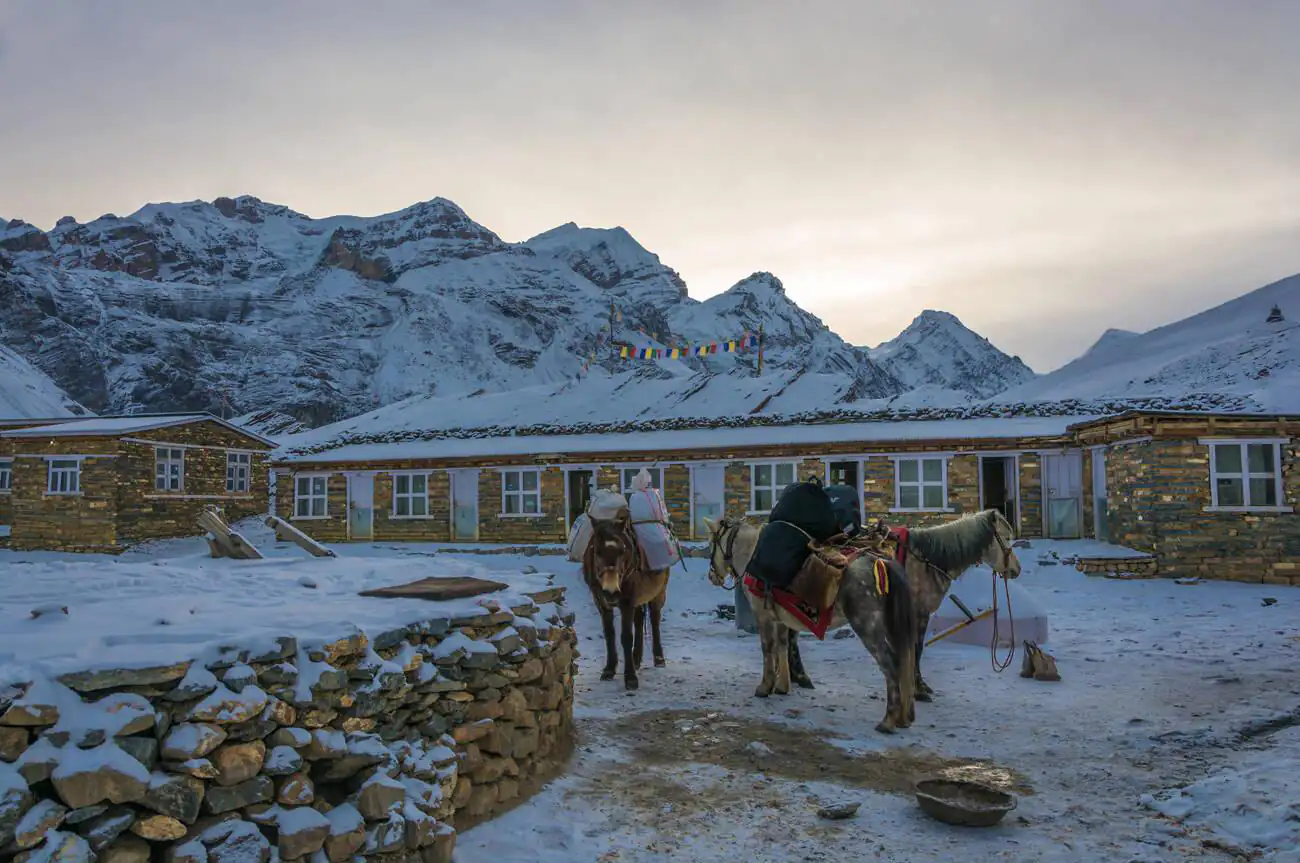
Safely Navigating and Appreciating Thorong La Pass
Thorong La Pass, perched at 5,416 meters on the Annapurna Circuit, challenges trekkers physically and mentally. Proper acclimatization and understanding the difficulties of this high-altitude trek are critical for a successful and safe trek.
Acclimatization to Combat Altitude Sickness
Proper acclimatization is vital for preventing altitude sickness, a condition caused by reduced oxygen at high elevations. Symptoms can vary from headaches to potentially life-threatening complications.
- Implement Gradual Ascents: Minimizing the risks of altitude sickness requires trekking at a slower pace. Incorporating rest days into your trek, particularly as you approach higher elevations, allows your body to adjust and reduces the likelihood of illness.
- Prioritize Hydration and Nutrition: Drinking ample water and consuming carbohydrate-rich meals are vital for maintaining energy and aiding acclimatization at high altitudes.
- Monitor Your Health Closely: Pay attention to signs of distress, like dizziness or extreme fatigue. If symptoms persist, immediate descent is necessary to prevent the condition from worsening.
Safety Measures and Emergency Preparedness
Trekking through Thorung La Pass demands stringent safety measures due to unpredictable weather and high-altitude challenges.
- Adhere to Emergency Protocols: Following emergencies, descending immediately to treat altitude illnesses is crucial. Carrying portable oxygen or having an emergency evacuation plan is advisable. To be prepared for any medical emergencies, research the closest healthcare facilities in Manang and Muktinath.
- Opt for Group Travel: Trekking with a group enhances safety, providing immediate access to assistance and shared resources.
- Essential Gear is a Must: Equip yourself with warm, waterproof clothing, trekking poles, and a comprehensive first-aid kit to handle the variable and often harsh Thorong La Pass weather.
Cultural Insights of Thorong La Pass
Beyond its trekking challenges, Thorong La Pass is steeped in cultural and historical significance, deeply rooted in the local communities of Manang and Mustang.
Local Traditions and Cultural Heritage
The communities near Thorong La Pass have maintained rich cultural traditions over the centuries, and their resilience and hospitality are widely recognized.
- Explore Buddhist and Hindu Traditions: The area around the pass is infused with spiritual sites, including prayer wheels, monasteries, and stupas, showcasing the deep spiritual ties of the local Sherpa, Gurung, and Thakali communities. The sacred Muktinath site further highlights the region’s spiritual significance.
- Experience Local Architecture and Festivals: Traditional stone houses in villages like Manang and various local festivals offer trekkers a glimpse into the vibrant cultural life that has thrived in these highlands for generations.
The Economic Role of Thorong La Pass
Historically, Thorong La Pass has served as a vital trade route, enhancing the economic ties between the Manang and Mustang regions by exchanging goods such as salt and wool.
- Observe Agricultural Practices and Livestock Management: Many residents rely on agriculture and livestock, with yaks playing a crucial role in transportation and regional economics.
- Recognize the Pass’s Role in Local Connectivity: For locals, Thorong La Pass is more than a trekking challenge; it’s a vital link for trade and family connections, illustrating the Pass’s role in sustaining community ties.
Accommodation and Amenities on the Thorong La Pass Route
Trekking to Thorong La Pass, known for its challenging elevation and stunning views, also offers a range of accommodation options. The route is dotted with lodges and tea houses that provide basic yet comfortable amenities, ensuring a restful stay after long trekking days.
Lodges, Tea Houses, and Facilities
- Manang to Thorong Phedi: The villages along the Annapurna Circuit, such as Manang, Yak Kharka, and Thorong Phedi, are well-equipped with lodges and tea houses. These accommodations offer basic amenities like clean rooms, hot meals, and common spaces to relax. Lodges in higher elevations may have fewer amenities, but most provide warm beds and dining areas with simple but hearty meals.
- Thorong Phedi and High Camp: Thorong Phedi, often the last stop before the climb to Thorung La Pass, offers several tea houses where trekkers can rest and prepare for the ascent. High Camp, a short distance above Thorong Phedi, also provides accommodation for trekkers looking to split their trek into shorter segments.
- Facilities Along the Route: Most tea houses offer communal bathrooms, basic showers (sometimes hot), and charging facilities for electronic devices, though they may charge an additional fee for electricity. Wi-Fi is available at many lower-altitude tea houses but becomes more limited or unavailable as you ascend.
Tips for the Best Stay
- Best Views: For trekkers seeking stunning views, staying in tea houses around Yak Kharka or Thorong Phedi offers unobstructed sights of the Annapurna range. Manang also offers several lodges with balconies that provide excellent panoramic views of the surrounding peaks.
- Book in Advance During Peak Seasons: The Annapurna Circuit, especially around Thorong La Pass, can get busy during peak trekking seasons. It’s wise to book your accommodation in advance or arrive early to secure a room, particularly in popular spots like Thorong Phedi and Manang.
- Carry Cash: Most tea houses do not accept credit cards, so it’s essential to carry enough cash to cover meals, accommodation, and extras like charging devices or hot showers.
Wildlife and Environment Around Thorong La Pass
The Thorong La Pass area is rich in dramatic landscapes, diverse wildlife, and unique plant species. The high-altitude environment supports a surprising variety of flora and fauna, offering trekkers a chance to witness nature’s beauty up close.
Unique Flora and Fauna
- Flora: As you ascend, the vegetation changes dramatically. In lower areas, you will trek through lush forests of rhododendrons, pines, and junipers. Higher up, the landscape turns into alpine meadows and barren, rocky terrain. Only hardy shrubs and grasses thrive at these altitudes, creating a stark yet beautiful contrast against the snow-covered peaks.
- Fauna: The region around Thorung La Pass is home to various wildlife species. Trekkers may spot Himalayan blue sheep, known locally as Bharal, grazing on the high slopes. Snow leopards also inhabit this area, although sightings are rare. Additionally, birds like Himalayan vultures and the elusive Himalayan Monal, Nepal’s national bird, can often be seen soaring above.
Conservation Efforts and Reducing Environmental Impact
- Conservation Initiatives: The Annapurna Conservation Area Project (ACAP) protects the fragile ecosystem around Thorong La Pass. ACAP focuses on preserving biodiversity, promoting sustainable tourism, and supporting local communities in conservation efforts. Trekkers are encouraged to support these initiatives by respecting local wildlife and habitats.
- Minimizing Impact: To reduce environmental damage, trekkers should adhere to the “Leave No Trace” principle. They should carry all trash back to the villages, use biodegradable products, and avoid disturbing wildlife. Staying on designated trails helps prevent erosion and protects delicate alpine flora. Consider water and electricity consumption in tea houses at higher altitudes, as resources are scarce.
Capturing the Beauty of Thorong La Pass: Photography and Memorable Experiences
Trekking across Thorong La Pass offers endless chances to capture stunning photos. This area is a dream for photographers with its breathtaking landscapes, dynamic skies, and towering peaks. The high altitude and rugged terrain around Thorung La Pass provide some of the most photogenic spots on the Annapurna Circuit.
Top Photography Spots
- Manang Village: Manang provides sweeping panoramic views of the Annapurna range. The best times for photography here are early morning or late afternoon when the light enhances the beauty of the snow-covered peaks and the surrounding valley.
- Thorong Phedi and High Camp: Thorong Phedi, located at the base of the pass, is ideal for photographing the dramatic terrain leading to Thorong La. A bit higher, High Camp offers fantastic opportunities to capture both the ascent and descent, with towering peaks framing the shot.
- Thorong La Pass Summit: At the summit of Thorong La Pass, trekkers enjoy expansive views of the Annapurna and Dhaulagiri ranges. The 5,416-meter elevation provides a perfect wide-angle shot, especially when the mountains glow golden at sunrise. Photographers should be mindful of battery life, as the cold can drain power quickly.
- Muktinath Temple: After crossing the pass, the sacred Muktinath Temple offers a culturally rich environment for photography. The temple’s architecture and surrounding mountains create a unique and serene setting, perfect for capturing spiritual and natural beauty.
Memorable Trekking Stories
- A Sudden Snowstorm Surprise: One trekker shared an unforgettable story of how the weather on Thorong La Pass shifted unexpectedly. Despite clear skies in the morning, a sudden snowstorm hit just before reaching the summit. What seemed like a challenging obstacle became magical as fresh snow covered the landscape, transforming the surroundings into a winter wonderland.
- Overcoming the Thorong La Pass Difficulty Together: A group of trekkers recalled the physical and emotional challenge of reaching the summit. Despite the thinning air and fatigue, they encouraged each other to push forward. Their shared accomplishment at the summit was a moment none of them will ever forget.
- Capturing the First Light at the Summit: One photographer described the thrill of capturing sunrise at the top of Thorung La Pass. The first light cast a golden hue over the Annapurna range, resulting in some of the most awe-inspiring photos of their trek.
Conclusion: The Unforgettable Experience of Thorong La Pass
Crossing Thorong La Pass provides physical challenges and unmatched natural beauty. The 5,416-meter elevation tests endurance, but the reward is an awe-inspiring view of the Himalayas. The weather at Thorong La Pass often adds an element of surprise, turning a challenging climb into an extraordinary experience.
Trekkers leave with beautiful photos and lasting memories of personal growth, teamwork, and triumph. Whether you’re a seasoned hiker or new to trekking, crossing Thorong La Pass leaves a deep and lasting impression, filled with accomplishment and a profound connection to the stunning environment.
